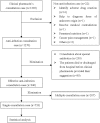Evaluation of the Effectiveness of Clinical Pharmacists' Consultation in the Treatment of Infectious Diseases: A Single-Arm, Prospective Cohort Study
- PMID: 30881307
- PMCID: PMC6405418
- DOI: 10.3389/fphar.2019.00187
Evaluation of the Effectiveness of Clinical Pharmacists' Consultation in the Treatment of Infectious Diseases: A Single-Arm, Prospective Cohort Study
Abstract
Background: With the implementation of Antimicrobial Stewardship Program, clinical pharmacists' consultation (CPC) for infectious diseases (ID) is gradually adopted by many hospitals in China. We conducted a cohort study to evaluate the effectiveness of CPC in ID treatment on patient outcomes and potential determinants. Methods: Based on a registry database, a prospective cohort study was conducted in Guizhou Provincial People's Hospital. The main exposure factor was whether clinician adopted the suggestion from clinical pharmacist. The outcome was effective response rate (ERR) of ID patients. The variables associated with the outcome (e.g., age, gender, severity of infection, liver function, and kidney function) were also prospectively recorded. A multilevel model was performed to analyze the factors related to ERR. Results: A total of 733 ID inpatients were included in the final analysis according to the predesigned inclusion and exclusion criteria. The proportion of clinical pharmacists' suggestions adopted by clinicians and ERR were 88.13 and 69.03%, respectively. Significant data aggregation (P < 0.05) for individuals at the level of department was observed. According to the two-level variance component model, liver dysfunction (Adjusted Odds Ratio (AOR) = 0.649, 95%Credible Interval (CI): 0.432-0.976), severity of infection (AOR = 0.602, 95%CI: 0.464-0.781), and adopting the suggestion from pharmacist (AOR = 1.738, 95%CI: 1.028-2.940) had significant association with ERR. Conclusion: Our study suggests that the effect of CPC on ID treatment is significant. The policy/decision makers or hospital managers should be cognizant of the critical value of clinical pharmacists in ID treatment.
Keywords: clinical pharmacists’ consultation; cohort study; infectious diseases; registry database; service.
Figures


Similar articles
-
The Effectiveness of Clinical Pharmacist-Led Consultation in the Treatment of Infectious Diseases: A Prospective, Multicenter, Cohort Study.Front Pharmacol. 2020 Sep 8;11:575022. doi: 10.3389/fphar.2020.575022. eCollection 2020. Front Pharmacol. 2020. PMID: 33013418 Free PMC article.
-
The Clinical Pharmacist-Led Consultation for Infectious Diseases in Guizhou Province, China: A Survey Among Hospital Pharmacies.Front Pharmacol. 2020 Feb 27;11:149. doi: 10.3389/fphar.2020.00149. eCollection 2020. Front Pharmacol. 2020. PMID: 32174837 Free PMC article.
-
Evaluation of a clinical pharmacist consultation service for patients with infectious diseases in China: a systematic review and meta-analysis.Eur J Hosp Pharm. 2020 May;27(3):131-136. doi: 10.1136/ejhpharm-2018-001815. Epub 2019 Jun 20. Eur J Hosp Pharm. 2020. PMID: 32419932 Free PMC article.
-
The Impact of Clinical Pharmacist Consultation on the Treatment of Multi-Drug Resistant Organisms (MDRO) Infections: A Retrospective Observational Study.J Multidiscip Healthc. 2025 May 28;18:2983-2995. doi: 10.2147/JMDH.S505931. eCollection 2025. J Multidiscip Healthc. 2025. PMID: 40458234 Free PMC article.
-
Practical, reliable, comprehensive method for characterizing pharmacists' clinical activities.Am J Health Syst Pharm. 1999 Dec 1;56(23):2444-50. doi: 10.1093/ajhp/56.23.2444. Am J Health Syst Pharm. 1999. PMID: 10595804 Review.
Cited by
-
Integrating Multidisciplinary Individualized Medication Recommendations Into the Traditional Pharmacists' Consultation Method: A Retrospective Study Using Propensity Score Matching Analysis.Inquiry. 2022 Jan-Dec;59:469580221081437. doi: 10.1177/00469580221081437. Inquiry. 2022. PMID: 35610968 Free PMC article.
-
Evaluation of interventions led by pharmacists in antimicrobial stewardship programs in low- and middle-income countries: a systematic literature review.Antimicrob Steward Healthc Epidemiol. 2024 Nov 11;4(1):e198. doi: 10.1017/ash.2024.342. eCollection 2024. Antimicrob Steward Healthc Epidemiol. 2024. PMID: 39563932 Free PMC article. Review.
-
Infection and the evaluation of biomarkers in obstetrics and gynecology patients with infectious disease: a retrospective observational study from clinical pharmacists' consultation experience.Eur J Med Res. 2022 Nov 3;27(1):229. doi: 10.1186/s40001-022-00850-5. Eur J Med Res. 2022. PMID: 36329535 Free PMC article.
-
The impact of pharmacist early active consultation (PEAC) on multidrug resistance organism treatment outcomes: A prospective historically controlled study.Front Pharmacol. 2023 Mar 2;14:1128219. doi: 10.3389/fphar.2023.1128219. eCollection 2023. Front Pharmacol. 2023. PMID: 36937879 Free PMC article.
-
The Effectiveness of Clinical Pharmacist-Led Consultation in the Treatment of Infectious Diseases: A Prospective, Multicenter, Cohort Study.Front Pharmacol. 2020 Sep 8;11:575022. doi: 10.3389/fphar.2020.575022. eCollection 2020. Front Pharmacol. 2020. PMID: 33013418 Free PMC article.
References
-
- Brink A. J., Messina A. P., Feldman C., Richards G. A., van den Bergh D. (2017). From guidelines to practice: a pharmacist-driven prospective audit and feedback improvement model for peri-operative antibiotic prophylaxis in 34 South African hospitals. J. Antimicrob. Chemother. 72 1227–1234. - PubMed
LinkOut - more resources
Full Text Sources

